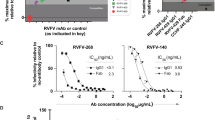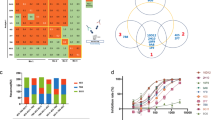Abstract
So far, no specific therapeutic agent is available for the treatment of ricin intoxication. Here, VH and VL genes were cloned from a hybridoma cell line secreting anti-ricin mAb 4C13, which could neutralize the toxicity of ricin. A chimeric antibody, c4C13, containing 4C13 mAb variable region genes fused to human constant region genes (gamma 1, kappa), was constructed. C4C13 retained the binding activity and recognized the same, or a closely related, epitope as the original mouse antibody. Furthermore, c4C13 blocked ricin-induced cytotoxicity to SP2/0 cells. Compared with its parental mouse antibody, c4C13 will be safer when used in human body to reverse clinical ricin intoxication.




Similar content being viewed by others
References
Balint GA (1974) Ricin: the toxic protein of castor oil seeds. Toxicology 2:77–102
Bigalke H, Rummel A (2005) Medical aspects of toxin weapons. Toxicology 214:210–220
Boulianne GL, Hozumi N, Shulman MJ (1984) Production of functional chimaeric mouse/human antibody. Nature 312:643–646
Furukawa-Stoffer TL, Mah DC, Cherwonogrodzky JW et al (1999) A novel biological-based assay for the screening of neutralizing antibodies to ricin. Hybridoma 18:505–511
Guo J, Shen B, Sun Y et al (2006) A novel neutralizing monoclonal antibody against both ricin toxin A and ricin toxin B, and application of a rapid sandwich enzyme-linked immunosorbent assay. Hybridoma 25:225–229
Guo JW, Shen BF, Feng JN et al (2005) A novel neutralizing monoclonal antibody against cell-binding polypeptide of ricin. Hybridoma 24:263–266
Korcheva V, Wong J, Corless C et al (2005) Administration of ricin induces a severe inflammatory response via nonredundant stimulation of ERK, JNK, and P38 MAPK and provides a mouse model of hemolytic uremic syndrome. Am J Pathol 166:323–339
Lemley PV, Amanatides P, Wright DC (1994) Identification and characterization of a monoclonal antibody that neutralizes ricin toxicity in vitro and in vivo. Hybridoma 13:417–421
Lindsey CY, Pace-Templeton JG, Millard CB et al (2006) Validation of ELISA for the determination of anti-ricin immunoglobulin G concentration in mouse sera. Biologicals 34:33–41
Miller RA, Oseroff AR, Stratte PT et al (1983) Monoclonal antibody therapeutic trials in seven patients with T-cell lymphoma. Blood 62:988–995
Porstmann T, Porstmann B, Wietschke R et al (1985) Stabilization of the substrate reaction of horseradish peroxidase with o-phenylenediamine in the enzyme immunoassay. J Clin Chem Clin Biochem 23:41–44
Rainey GJ, Young JA (2004) Antitoxins: novel strategies to target agents of bioterrorism. Nat Rev Microbiol 2:721–726
Sandvig K, van Deurs B (2005) Delivery into cells: lessons learned from plant and bacterial toxins. Gene Ther 12:865–872
Schmidt A, Muller D, Mersmann M et al (2001) Generation of human high-affinity antibodies specific for the fibroblast activation protein by guided selection. Eur J Biochem 268:1730–1738
Shuntao W, Jiannan F, Jianwei G et al (2006) A novel designed single domain antibody on 3-D structure of ricin A chain remarkably blocked ricin-induced cytotoxicity. Mol Immunol 43:1912–1919
Smallshaw JE, Richardson JA, Pincus S et al (2005) Preclinical toxicity and efficacy testing of RiVax, a recombinant protein vaccine against ricin. Vaccine 23:4775–4784
Acknowledgements
This study was supported by National Sciences Fund (No. 30490240) of China.
Author information
Authors and Affiliations
Corresponding author
Additional information
Yugang Wang and Leiming Guo contributed equally to this work.
Rights and permissions
About this article
Cite this article
Wang, Y., Guo, L., Zhao, K. et al. Novel chimeric anti-ricin antibody C4C13 with neutralizing activity against ricin toxicity. Biotechnol Lett 29, 1811–1816 (2007). https://doi.org/10.1007/s10529-007-9478-3
Received:
Revised:
Accepted:
Published:
Issue Date:
DOI: https://doi.org/10.1007/s10529-007-9478-3




